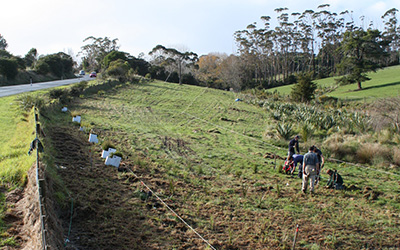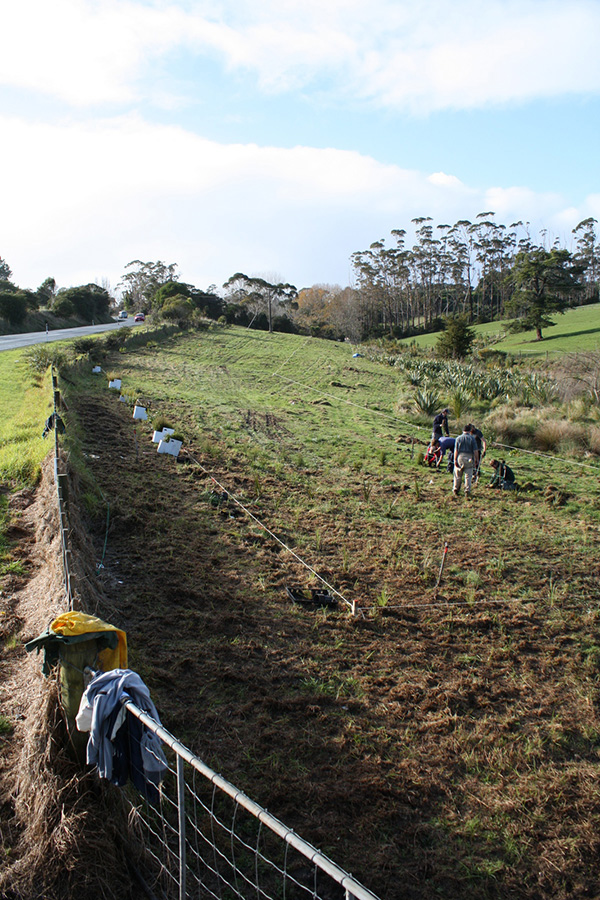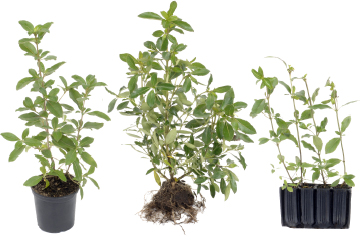Open-ground indigenous plant trials another string


Tree Scientist’s Dream: The Sandspit Road site is accessible, even in gradient and in soil type, and sufficiently broad to accommodate the plots of six species times the three plant-raising methods. photographer Michael Bergin
Dr David Bergin is well underway laying out the second and third open-ground trial sites, at Silverdale, using another mile of string and three of his adult and late teens children.
The site beside Sandspit Road is textbook—imminently accessible and sufficiently large to accommodate eight replications of the randomised trial layout.
The Silverdale site is far from accessible but, being part of a large indigenous restoration project, has ample space for two blocks the size of that at Sandspit Road.
With the core trial sites decided, there is now an opportunity to establish a quite different trial—another string to the trial’s bow. This second trial will seek to compare open-ground plants with container-raised plants, in a toetoe filler trial.
Background to toetoe as a filler species
One of the strands that intertwined to form the open-ground project was the notion that harakeke might be used as a magic bullet to quickly establish indigenous plants in the Mahurangi catchment—tūī are know to use the stalks as a perch, even when the flax is not flowering, and defecate the seeds of woody shrub species, which find a perfect the ground beneath the flax bushes a conducive nursery.
Fortunately for the project, the Waitakere City Council indigenous restoration expert Chris Ferkins warned that harakeke is too slow growing to beat the weeds on its own, and proceeded to describe his success with toetoe.
Now toetoe, in the northern part of the North Island is generally unloved. But in fact it is all but non-existent, compared with the loathsome South American pampas grass, which tragically is now endemic. The quick way to identify this exotic pest is by the profusion of curled leaves at the base. The indigenous species don’t have these carpenter’s plane-like leaves. Nor do they have the vicious, razor-sharp edges.
Chris has found that making every other plant a toetoe, checkerboard-style, weeds are beaten in around nine months. Then, because toetoe is light-dependant, it eventually bows out in favour of the taller growing shrubs and trees planted.
Two factors are responsible for the high cost of establishing indigenous species, as compared with exotics:
- The cost of plants
- The cost of maintenance.
Depending on plant size and spacing, up to eight years of maintenance might be necessary to protect plants from competition by weeds—kikuyu the killer in the north, blackberry the bête noire of the south.
If open-ground methods can provide high volumes of large, vigorous toetoe plants cheaply, and these as filler plants can be shown to reduce the cost of establishment of target indigenous species, and the need for herbicides, a pivotal breakthrough will have been achieved.
Natural Heritage Fund
In addition to suitable sites for the toetoe trial, thousands of plants from the nursery trial are now available, at cost, for planting out this winter.

Take Your Pick: Container-grown $2.85; open-ground $1.55; root trainer (each) $1.10. photographer Jonathan Barran
A number will go to those who donated money to help launch the project, in ‘the reasonable expectation’ of receiving plants.
The Rodney District Council natural heritage fund can help with plant costs, if the property owner is willing to contribute a like value—for example, by providing the labour for the planting.
The cost of the plants, delivered to the Mahurangi are:
- PB3 planter bag or pot $2.85
- Open-ground $1.55
- Root trainer $1.10
So many trials, so little funding
Properly designed, scientifically designed trials are an expensive undertaking.
This project is seeks to demonstrate that indigenous species raised open-ground can be competitive with standard container-grown stock. But there are a myriad treatments to be trialled, to enable indigenous trees to be established economically, including for the sustainable production of quality timber.
Dilettantes—in the non-pejorative sense of the word—can help by exploring avenues that, if sufficiently promising, can be followed up with appropriate scientific rigor.
See also Open-Ground Indigenous Plants Report
